

Whether you’re a resort rider or like to earn your turns, a high-quality jacket is an essential part of every snowboarder’s kit. Over the years, we’ve seen performance gradually catch up with style, and today’s offerings deliver a really impressive dose of weather protection alongside cozy comfort and fun freeride vibes. Core snowboard brands like Burton, Volcom, and Jones comprise the majority of the market, but you won’t want to overlook premium designs from Arc’teryx, Patagonia, and Outdoor Research (among others). Below we break down the 16 best women’s snowboard jackets of 2025, from high-end Gore-Tex shells to insulated resort pieces and functional 3-in-1 combos. For more background information, see our comparison table, buying advice, and testing practices below the picks. And for a wider look at the market, check out our round-up of the best snowboard jackets, which covers both men's and women's styles.
Editor's note: We updated this guide on March 21, 2025, to add the Mountain Hardwear Boundary Ridge GTX and Trew Gear Stella Jacket Primo to our list. We removed any out-of-stock jackets and swept the guide to ensure all other specs, blurbs, and information were up to date at the time of publishing.
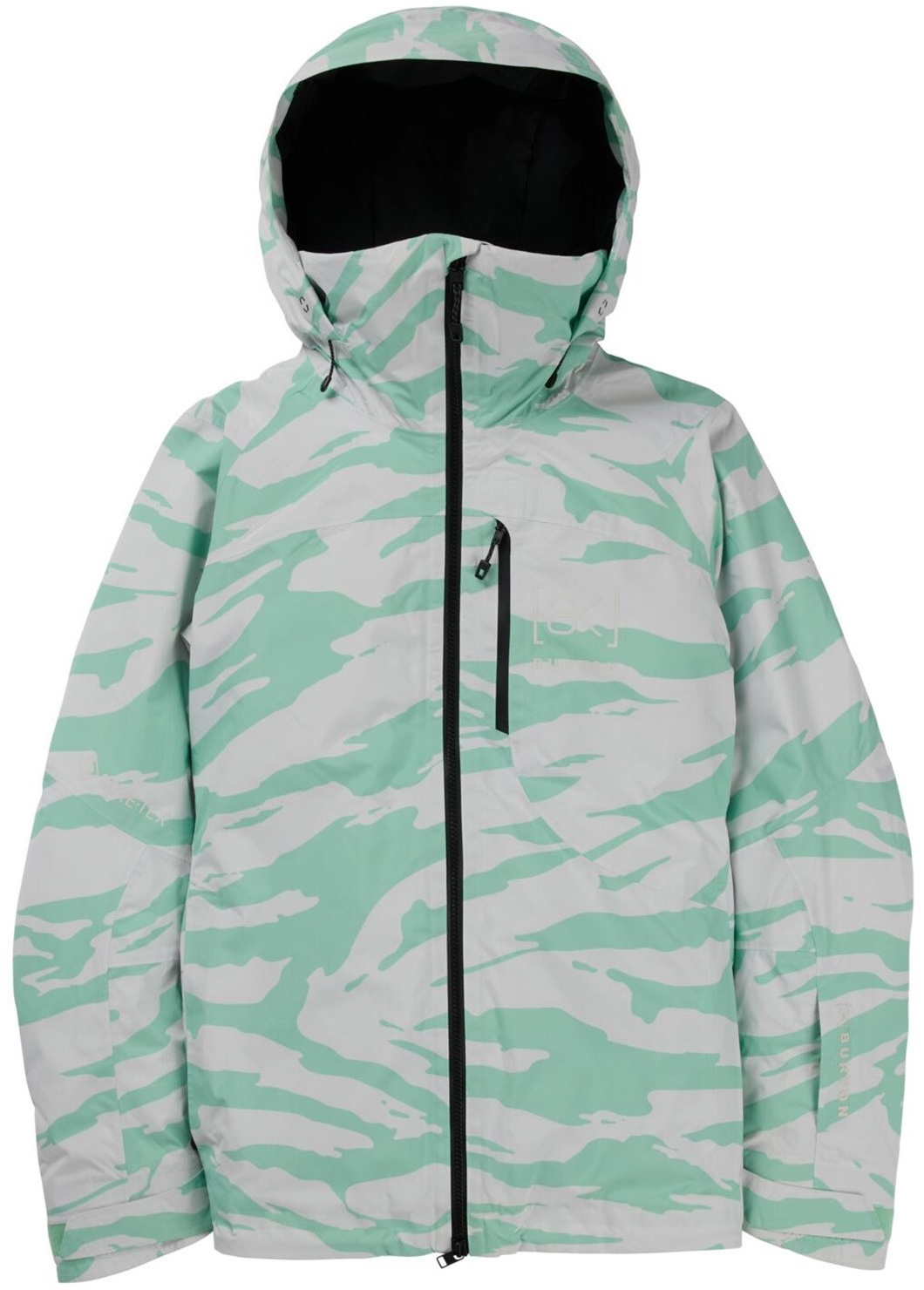 Category: Insulated
Category: Insulated
Insulation: PrimaLoft Silver (60g)
Waterproofing: 2L Gore-Tex
What we like: A warm, weatherproof, and stylish resort jacket from snowboarding’s marquee apparel brand.
What we don’t: When left off, the hood (and collar) funnels snow into the jacket.
Burton is practically synonymous with snowboarding, and the [ak] badge represents their high-performance collection of outerwear. The Embark is the most popular women’s jacket in the lineup, deftly balancing weatherproofing, warmth, and style for resort riders. We put the Embark through the wringer during a stormy PNW winter and it stood up to the test: The 2-layer Gore-Tex membrane proved impermeable even on the wettest of days, the insulation offered a nice dose of warmth without too much bulk, and the feature set checked (almost) all the boxes. We particularly loved the lightweight and quick-drying wrist gaskets, fleece-lined collar, goggle-sized internal pocket, and insulated chest pocket, which kept our phone warm and dry throughout days on the slopes.
Our main gripe with the [ak] Embark is its oversized hood and collar. While it’s nice to have a hood that sufficiently swallows our helmet on storm days, the Embark’s design has inherent vulnerabilities when left off: It collects snow and funnels it through the baggy collar, straight into the jacket (unfortunately, there’s no way to snug up the collar). In terms of fit, we found the jacket to run fairly large (given its insulated design, we’d often layer it over just a thin wool baselayer), but were still happy that we sized up for a baggier fit. Gripes aside, the Embark is an easy “yes” for resort riders looking for a stylish yet weatherproof jacket and our top overall pick of the 2024-2025 season. For a non-insulated version that will be a better match for mild spring conditions, check out the [ak] Upshift Gore-Tex 2L.
See the Burton [ak] Embark Gore-Tex 2L
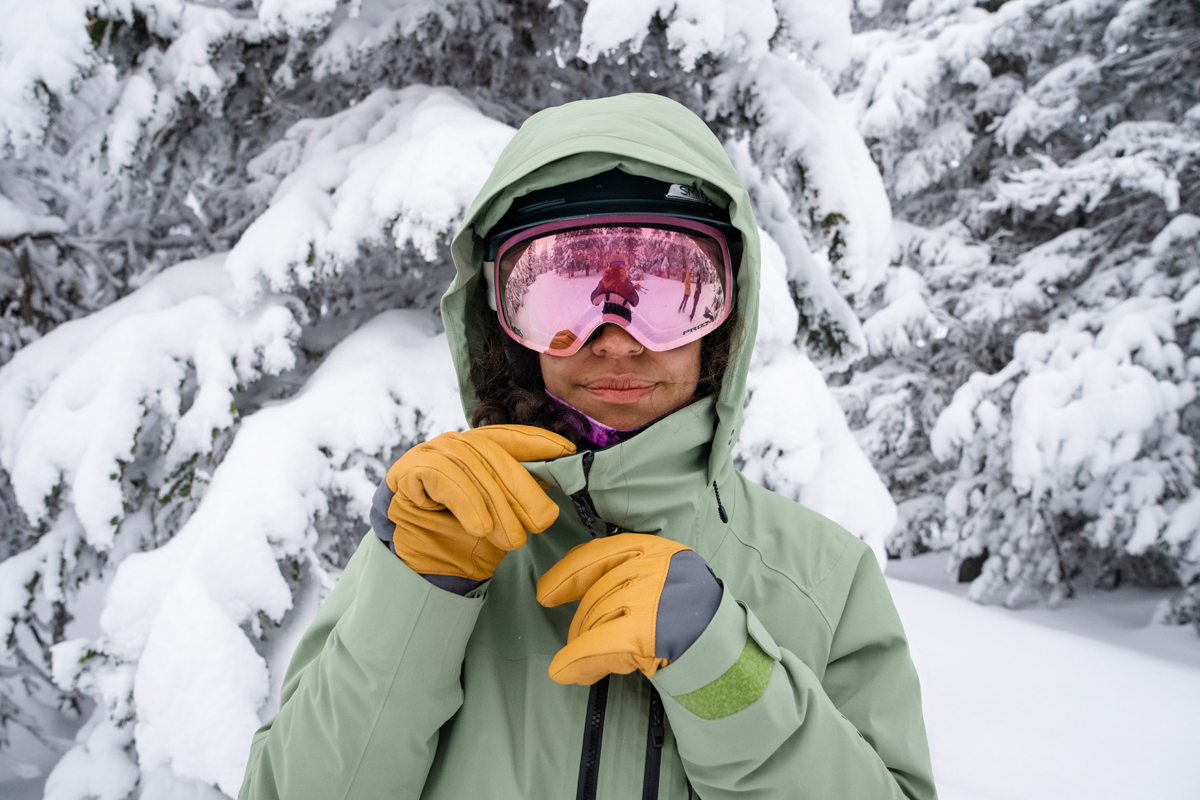
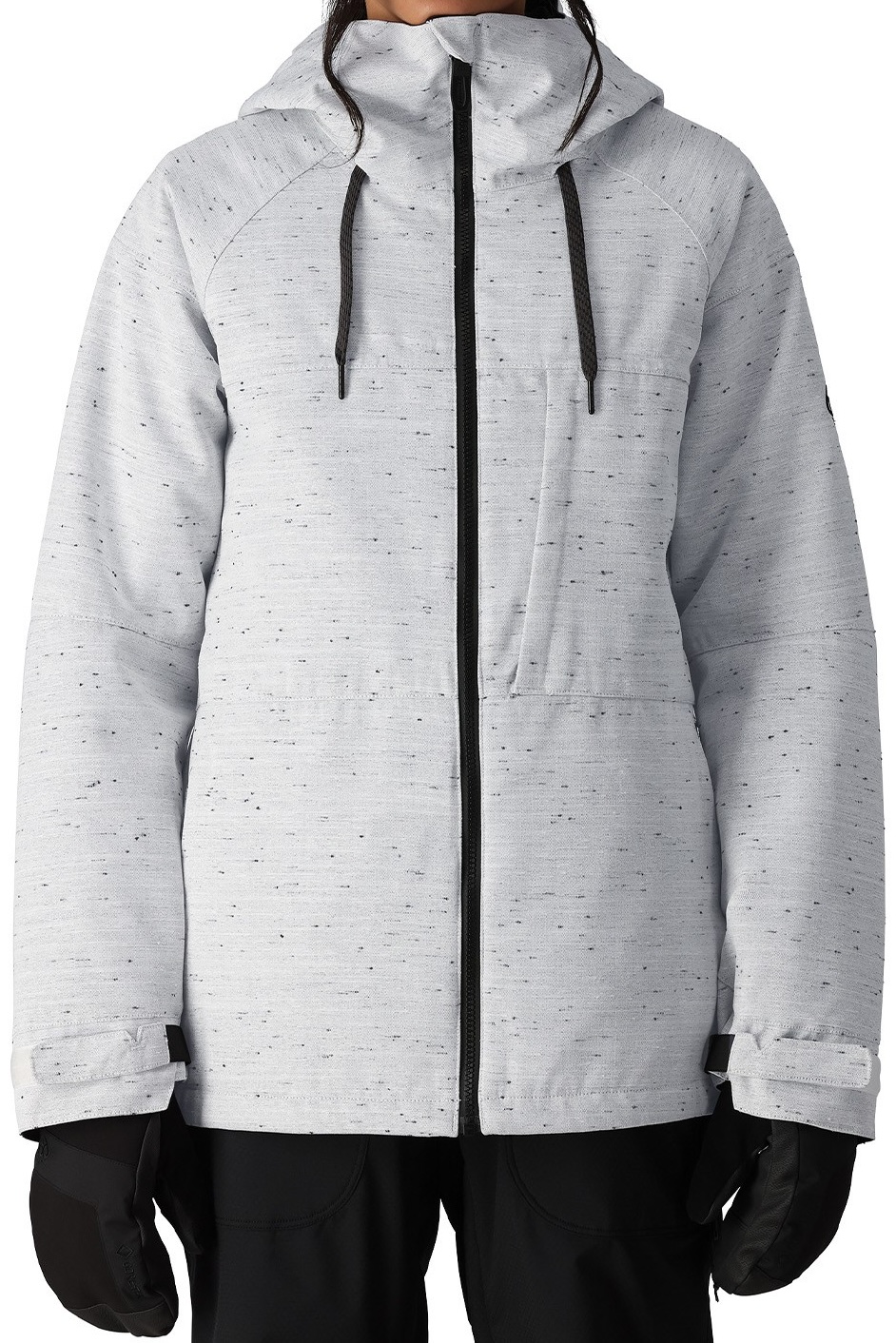 Category: Insulated
Category: Insulated
Insulation: 80g (body); 60g (sleeves); 40g (hood)
Waterproofing: 2L infiDRY
What we like: A warm and affordable design from a well-respected brand.
What we don’t: Not well suited for particularly wet or mild climates.
Not every snowboarder wants to spend upwards of $500 on a jacket, especially if you only get out a few times a year. For those looking to keep prices low, the 686 Athena Insulated is a good place to start. For just $230, this jacket offers a basic but well-rounded feature set, a nice array of color options, and 10K/10K waterproofing and breathability thanks to 686’s infiDRY membrane. It’s also a cozy place to be, with 80-gram insulation in the body, 60-gram fill in the arms, and an even lighter 40g in the hood. A key highlight is storage (something many budget jackets cut back on): The Athena features a dedicated pass pocket, phone heater pocket, drop-in mesh pocket for goggles or gloves, and even a zippered chest pocket with an included key clip. Tack on pit zips and a powder skirt, and the Athena checks a whole lot of boxes for resort days.
We do hesitate to recommend the Athena for those based in wet climates like the Pacific Northwest. Along with the low 10K waterproof rating (more premium jackets are rated up to 20K), the jacket is only taped at the critical seams and will certainly spring a leak when drenched. Further, you get limited hood adjustability: With only simple drawcords at the front, you can’t batten down the hatches and secure the hood in rough weather as effectively as the pricier Burton above. And finally, the insulated design lacks versatility for mild spring days. But if you’re a casual rider who only gets out a few times a year, the Athena Insulated offers a whole lot and looks good to boot. For a low-cost alternative from Burton, check out the Jet Ridge ($240) below.
See the 686 Athena Insulated
 Category: Shell
Category: Shell
Insulation: Light flannel backer
Waterproofing: 3L Gore-Tex ePE
What we like: High-end fit and finishes; premium 3-layer Gore-Tex weatherproofing.
What we don’t: Pricey; might be too warm for spring touring.
Many resort riders will appreciate the added warmth of an insulated jacket, but they’re a no-go for bootpacking into the sidecountry or splitboarding. If you’re earning your turns, a 3-layer shell will give you full control over your layering, along with best-in-class breathability. Arc’teryx’s legendary Sentinel jacket has long been a pinnacle jacket for off-trail exploration: You get a reliable 3-layer Gore-Tex construction (recently updated to their more sustainable ePE membrane) with a light flannel backer, a brilliantly designed hood, and water-resistant zippers throughout. Further, the pockets are an ode to Arc’teryx’s thoughtful design—including an internal dump stash and hipbelt-compatible hand pockets—and pit zips allow you to release heat on the uphill. For one of the most premium freeride touring shells, look no further than the Sentinel.
At $750, the Sentinel is not cheap, but you get what you pay for. Among 3-layer Gore-Tex shells, Arc’teryx’s design and build quality are truly hard to beat. It’s also decently lightweight for what you get (1 lb. 5.3 oz.) and streamlined enough to stuff into your pack during high-intensity climbs. On the other hand, it might be a bit too much jacket for some uphill enthusiasts, namely due to the flannel backer—some riders will prefer a standard (i.e., not ski- or snowboard-specific) hardshell instead or even opt for a lightweight softshell or wind jacket on the skin track. But for everything from powder riding at the resort to deep-winter touring, the Sentinel offers a near-ideal combination of comfort, weight, and weatherproofing, making it a technical standout.
Read more: Arc'teryx Sentinel review (previous version)
See the Arc'teryx Sentinel

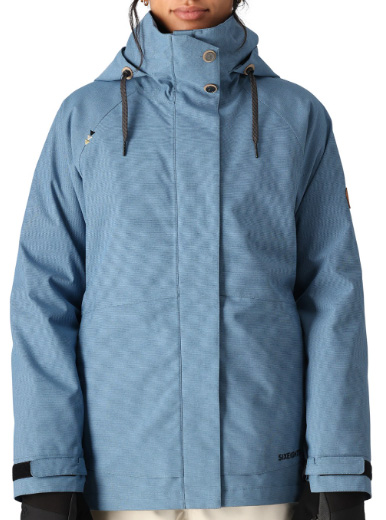 Category: 3-in-1
Category: 3-in-1
Insulation: Synthetic (100g) & fleece
Waterproofing: 2L infiDRY
What we like: A versatile and affordable design with really fun styling.
What we don’t: Bulky and not particularly breathable.
The 686 Smarty 3-in-1 Spellbound offers the height of versatility for riders just starting to build their kit. With the 3-in-1 design, you get a 2-layer shell with a 10K waterproof rating and fully taped seams, along with a cozy synthetic midlayer with fleece sleeves. On midwinter days, zip the two jackets together for a warm integrated piece; on mild days, wear just the shell (over a baselayer, that is) and save the midlayer for après. And 686 didn’t skimp on style, with fun stitching details at the cuffs and collar, cozy sherpa fleece at the midlayer’s neck and sleeves, and a trendy relaxed fit. For just $300, it all adds up to a true steal of a deal.
In terms of features, the Smarty Spellbound packs in everything the modern resort rider might need. You get a chest pocket with built-in cord routing for your headphones, internal goggle pocket, powder skirt, pit zips, and more. However, 3-in-1s do have their compromises: They’re consistently the heaviest and bulkiest options due to the extra zippers and snaps, and the two-piece system can be drafty compared to a dedicated insulated jacket. Finally, the Smarty's 2-layer shell is far from a high-performance piece, and lacks sufficient breathability for backcountry use. But for those wanting to maximize versatility and value for lift-assisted or terrain park days, the 686 Smarty is our favorite 3-in-1 design. Within this category, other options include The North Face’s ThermoBall Snow Triclimate (outlined below) and Patagonia’s 3-in-1 Powder Town.
See the 686 Smarty 3-in-1 Spellbound
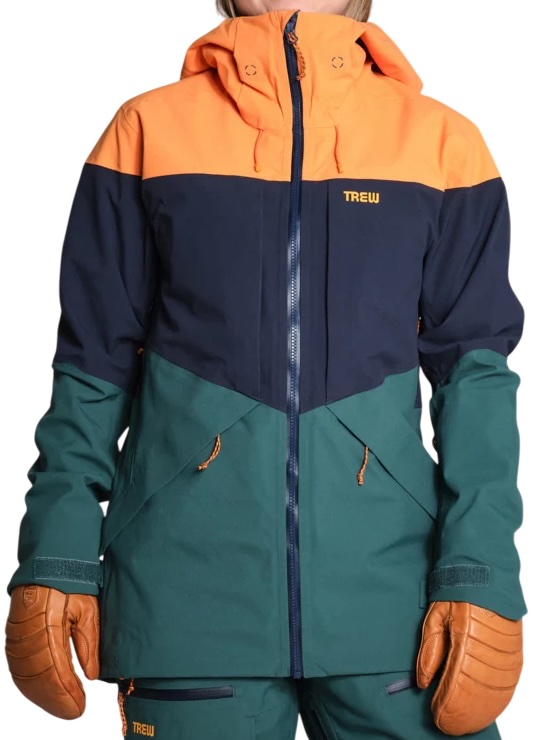 Category: Shell
Category: Shell
Insulation: None
Waterproofing: 3L PNW Primo
What we like: Stylish, durable, and very weather protective.
What we don’t: Pretty heavy for an uninsulated shell.
For those who haven’t been introduced, Trew Gear is an Oregon-based company that excels in the mid-range of the resort and backcountry markets. Their designs are super well made and have clean styling—the look and feel often reminds us of Gore-Tex—and durability and weatherproofing are performance hallmarks. The women’s Stella Primo is their core, uninsulated 3-layer jacket that hits a desirable combination of price ($499), toughness, and coverage. Added up, it excels in the kind of conditions you learn to accept in the Pacific Northwest: wet, rowdy, and—at times—deep.
We think Trew Gear nailed the Stella’s style, with a long cut, angled pockets, and a fun flare at the cuffs. They also managed to check the right boxes with features like pit zips and a nice assortment of interior and exterior pockets. One downside of the build is that it’s pretty heavy for a jacket that lacks insulation (at 1 lb. 13.5 oz., it's about 10 oz. heavier than the Sentinel above), so we wouldn’t recommend hauling it on any significant splitboard adventures, and mobility is a bit compromised by the thick shell. But for over $250 less than the Sentinel, it’s a well-sorted, long-lasting, and very weather-protective shell for resort riders or those who access backcountry terrain via heli or snowmobile. It's also worth considering the Stella Classic ($449) which has a similar vibe and thinner shell (at the sacrifice of durability and weatherproofing).
Read more: Trew Gear Stella Jacket Primo review
See the Trew Gear Stella Jacket Primo
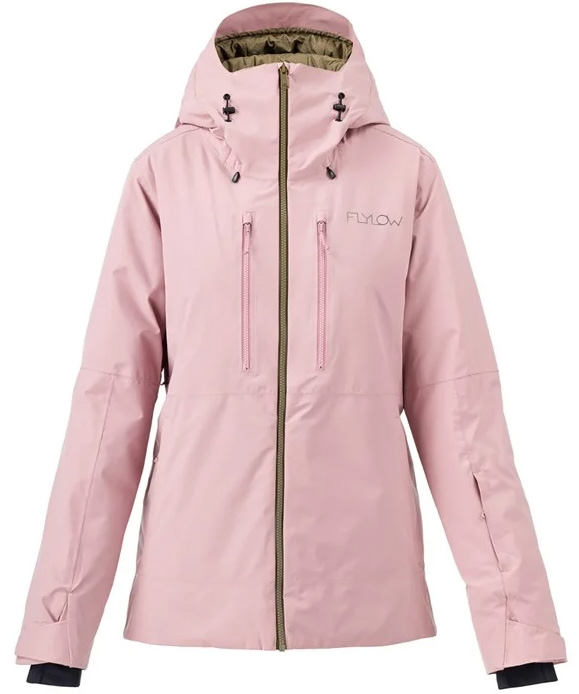 Category: Insulated
Category: Insulated
Insulation: Greenloft (100/80g)
Waterproofing: 2L Lux
What we like: Stretchy and warm, with quality materials throughout.
What we don’t: Not ideal for mild temperatures; can’t match the protection or quality of Gore-Tex.
Pairing a supple and stretchy shell with some heavy-duty warmth is Flylow’s Avery. This comfort-first jacket features a stretchy face fabric, puffy-like baffled interior, and 100 grams of Greenloft insulation (80g in the sleeves and hood) to keep you warm on the coldest of days. You also get cozy wrist gaskets and a removable powder skirt, which go a long way toward keeping snow at bay. And finally, styling is a high point, with fun colorways, contrasting zippers, and a functional yet flattering fit. Not only is the Avery one of our resort jackets of choice for cold days, but it’s such a class act that we’ll also throw it on to walk the dog, shovel the driveway, or wear around town.
The Avery is ideal for resort riding in temperatures around 20 degrees or colder, but it starts to show its weaknesses in warmer conditions or during quick slogs to the sidecountry. The jacket’s Lux membrane falls short of Gore-Tex in terms of both waterproofing and breathability, and the stretchy and relatively thin (40D) face fabric has a tendency to absorb moisture. What’s more, the Avery is far from the most durable jacket here—after just a month and a half of regular wear, ours had already gathered some light piling at the sleeves, wrists, and chest, in addition to a smattering of stains throughout. All told, the Flylow can’t match the premium quality of Burton’s [ak] lineup or Arc’teryx’s shells, but for $450, it’s nevertheless a very capable and fun jacket for cold days at the resort.
See the Flylow Avery
 Category: Shell
Category: Shell
Insulation: None (fleece liner)
Waterproofing: 2L Gore-Tex ePE
What we like: Industry-leading sustainability, burly construction, and decent breathability for both resort and sidecountry use.
What we don’t: Pricey for a 2-layer jacket; not styled for snowboarders in particular.
Patagonia’s snow jacket lineup is designed for both skiers and snowboarders, and headlining their resort offerings is the venerable Storm Shift. The Storm Shift features a hardwearing 150-denier shell and Gore-Tex waterproofing, which has kept us bone dry in wet PNW conditions. Breathability is top notch for a 2-layer design, thanks to the premium membrane, wicking fleece liner (reminiscent of Patagonia’s R1 Air material), and pit zips that will keep you reasonably cool and comfortable on uphill jaunts into the sidecountry. Finally, we’ve found the Storm Shift to be surprisingly supple and mobile despite the thick fabric. It all adds up to a high-end jacket for serious resort riders who put a lot of mileage on their gear.
The headlining story with the Storm Shift is its fully PFAS-free Gore-Tex design (most of their products use a PFAS-free DWR, but the harmful chemical is still present in some Gore-Tex membranes). But it doesn't come cheap: At $499, the Storm Shift matches the Burton [ak] Embark above as the priciest 2-layer Gore-Tex jacket here and is around $50 more than the Backcountry Cottonwoods below. Compared to the Backcountry, the Patagonia does include a nicer and more durable face fabric, softer liner, and more thoughtful organization. And held up against the Burton, it’s overall a more premium jacket, although it lacks the snowboard-specific style (and added insulation). All told, if you value premium build quality and are willing to pay the price, the Storm Shift is one of the most well-made resort shells here. For a step down from Patagonia, check out their Powder Town ($349) and Insulated Powder Town ($399) jackets.
See the Patagonia Storm Shift
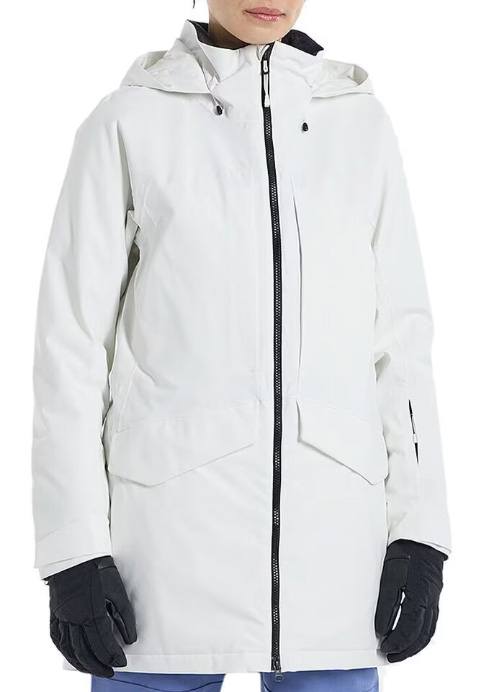 Category: Insulated
Category: Insulated
Insulation: ThermacoreEco (60g)
Waterproofing: 2L Dryride
What we like: A versatile jacket that’s stylish both on and off the slopes.
What we don’t: Heavy and will wet out in heavy snow.
If rule number one for you is “look good,” the Burton Prowess 2.0 2L could be just the ticket. Big on style, the Prowess features a long and contoured drop hem, fun cargo-style front pockets, and wide cuffs that look the part both on and off the hill. What’s more, the stretch polyester shell has the same casual vibe and weighted feel as your urban winter jacket, and the plush insulation and sherpa fleece liner is cozy next-to-skin. You’ll want to wear it around town, but the Prowess is also fully ready for the slopes with pit zips, an in-house Dryride waterproof membrane, a removable powder skirt, and a large assortment of pockets.
There’s a lot to like about the Burton Prowess, including its price: For $300, it’s a very versatile, warm, and weather-resistant jacket that you could potentially wear every day of the winter. But it’s simply not for serious riders. The polyester shell will wet out after sustained exposure to moisture (it doesn’t help that only the critical seams are taped), and the jacket is a relative behemoth in terms of heft and bulk. As a result, we don't love it for wet climates like the Pacific Northwest, and it’s not a super feasible option for bootpacking into the sidecountry. But if you’re a casual rider in dry areas like Colorado or Utah, the Prowess 2.0 offers a really fun combination of style and performance.
See the Burton Prowess 2.0 2L
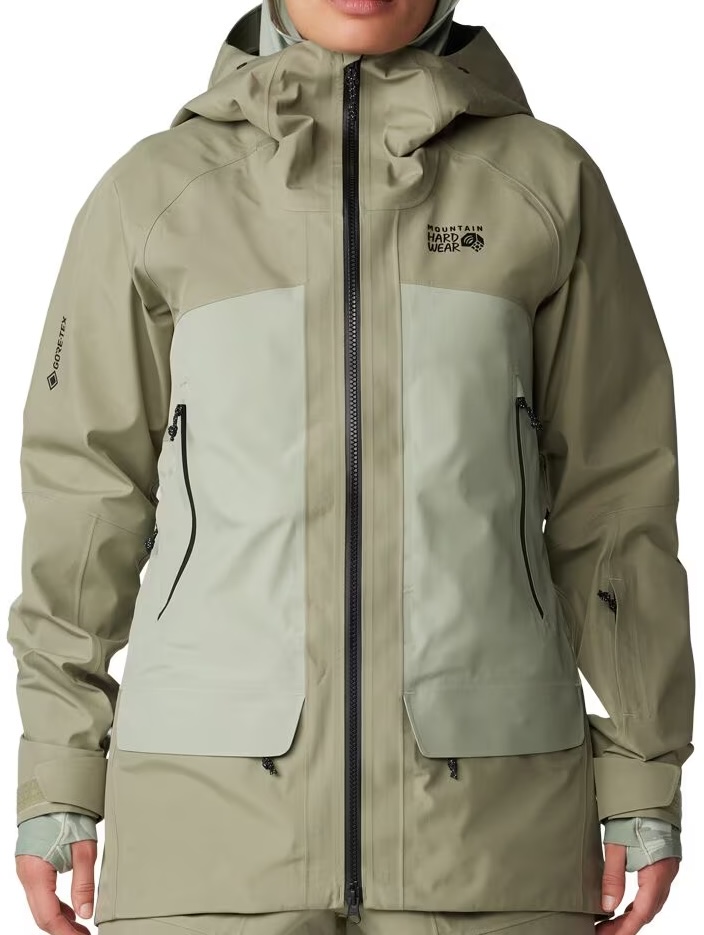 Category: Shell
Category: Shell
Insulation: None
Waterproofing: 3L Gore-Tex
What we like: A stylish and premium 3L Gore-Tex shell for big-mountain riders.
What we don’t: Heavy and fit can be tricky.
There’s no shortage of 3-layer Gore-Tex shells, but it’s not every day that the premium tech is combined with a healthy dose of freeride style. Enter the Mountain Hardwear Boundary Ridge GTX, one of the steeziest yet most serious jackets here. With a long and baggy cut, large pockets, and beefy cuffs, the Boundary Ridge looks the part in big-mountain terrain, and it’s prepared for all manner of conditions, too: The burly 75-denier shell is confidence-inspiring in heavy snowfall, and you can batten down the hatches with features like a powder skirt and pant attachments, drawcord hem, high collar, and high-quality hood with three-way adjustment. Added up, the Boundary Ridge is purpose-built for serious days in the backcountry, whether your access is via snowmobile, heli, or boot pack.
It’s hard to beat the mix of protection and breathability of 3-layer Gore-Tex, and the Boundary Ridge also features large pit zips for dumping heat in a hurry. And at 1 pound 7.4 ounces, it's not considerably heavier than the Sentinel above—although, like the Arc'teryx, some uphill enthusiasts will still find it to be a bit too much jacket during sweat-inducing climbs (better to get a softshell or more air-permeable design in that case). But for deep-winter pow days, slackcountry riders, or those with motorized access to big terrain, the Mountain Hardwear is a protective and stylish alternative that will save you about $200. It is worth noting that many women have struck out on fit with the Boundary Ridge—we recommend trying the jacket on before buying, or purchasing from a retailer with a convenient return policy. But there’s nevertheless a lot to like about this shell, which will keep you dry both in and out of the ropes.
See the Mountain Hardwear Boundary Ridge GTX
 Category: Insulated
Category: Insulated
Insulation: PrimaLoft Black Eco (100g)
Waterproofing: 2L Helly Tech Performance
What we like: Great performance for less than much of the competition.
What we don’t: Among snowboarders, Helly Hansen doesn’t have the brand cachet of names like Burton and Volcom.
Helly Hansen is a big name among skiers, but their Powchaser 2.0 is a very suitable option for snowboarders, too. This jacket has performance and style in spades: Freeride vibes and fun colorways check the steezy box, and high-quality materials take it to the next level, including Helly Hansen’s premium Helly Tech Performance waterproofing and low-bulk PrimaLoft Black Eco insulation. A healthy set of features rounds out the build: You get pit zips, wide cuffs, an adjustable powder skirt and hood, and pockets galore.
Helly Hansen’s offerings are often priced lower than the competition, and the Powchaser 2.0 is no exception. Compared to jackets like the Volcom 3D Stretch and Burton [ak] Embark above, the Powchaser 2.0 saves you $70 to $150 with very few compromises. Of course, Burton and Volcom’s brand cachet will appeal to many snowboarders, and it’s hard to beat the reliability of Gore-Tex waterproofing. But Helly Tech Performance is a very solid alternative, and we’ve found Helly Hansen’s build quality to be on par with that of the aforementioned offerings. We won’t blame you if your allegiance is to cult snowboard companies, but the Powchaser 2.0 is certainly worth considering. And for a step up in warmth and waterproofing, check out Helly Hansen’s more premium Powderqueen ($450).
See the Helly Hansen Powchaser 2.0
 Category: Shell
Category: Shell
Insulation: None
Waterproofing: 3L YamaPro
What we like: A stylish 3-layer design for a considerable $250 less than the Sentinel above.
What we don’t: Issues with durability and waterproofing; lots of features for a backcountry shell.
Based in Japan’s powder capital, Oyuki has a growing lineup of outerwear designed for skiers and snowboarders. Their jackets combine fun freeride styling with real-deal performance, and the Nimi sits at the top of the food chain. Combining Oyuki’s in-house YamaPro waterproof membrane with a lightweight and supple face fabric (noticeably thinner than most shells here), the Nimi is a comfortable and breathable option for mild climates and those who split their time on and off trail. Along with the stretchy build and great freedom of movement, we particularly loved the jacket’s stylish fit and nice finishes, including a high collar, artsy seam taping, well-designed cuffs, and a large hood.
But we do hesitate to rank the Nimi among the ranks of jackets like the Sentinel and Stella above. For one, its durability has been disappointing: After one season, the laminated logos are peeling off, the fabric zipper pulls have unraveled, and raw edges of frayed material are showing around the seam tape. What’s more, the face fabric routinely wets out, and the YamaPro membrane is prone to being overwhelmed by moisture, too. Finally, the Nimi seems to have a bit of identity confusion—on one hand, it’s a lightweight option for weight-conscious backcountry missions; on the other, it’s overly featured (with a few too many pockets), yet the pit zips are on the small side. We gotta hand it to Oyuki for making a very comfortable, stylish jacket, but it needs some refinement to be competitive with the other 3-layer options here.
See the Oyuki Nimi YamaPro
 Category: Insulated
Category: Insulated
Insulation: Thermal STD (40/60g)
Waterproofing: 2L Dryplay
What we like: A fun and functional fairweather snowboarding jacket for just $335.
What we don’t: Unreliable waterproofing.
A relative newcomer to the world of snowboard jackets, Picture Organic has set themselves apart from the competition with sleek styling, competitive pricing, and a strong focus on sustainability. Their products incorporate recycled materials and PFAS-free DWR treatments, and the company also recently became a certified B Corp (joining Burton, Patagonia, and others). The Seen is their insulated 2-layer resort jacket, built to keep you warm on the lift without overheating during rowdy resort laps. You get a 20K/20K waterproof breathable membrane, insulation throughout the body and sleeves, pit zips, and a soft tricot lining for day-long comfort.
Like the Flylow Avery above, the Seen is a great choice for cold days at the resort but woefully unprepared for wet conditions. No match for Gore-Tex, Picture Organic’s Dryplay membrane was quickly overwhelmed by moisture during our testing (one day even prompting a full change of layers at lunch) and unfortunately did not live up to its 20K specification. But if you don’t need to prioritize waterproofing (say, if you’re a fair-weather snowboarder, live in the Rockies, or don’t mind the excuse to head to the lodge to dry out), the Seen is a really fun jacket: We loved the wide assortment of features—particularly the lycra wrist gaskets, removable goggle wipe inside the chest pocket, and snug-fitting powder skirt—and the styling and colorways are unique and eye-catching. And for just $330, it’s one of the more affordable options on our list.
See the Picture Organic Seen JKT
 Category: Shell
Category: Shell
Insulation: None
Waterproofing: 3L Gore-Tex; 2L Gore-Tex w/ Stretch
What we like: Excellent mix of mobility, ventilation, and weather protection.
What we don’t: Expensive and purpose-built for the backcountry.
Outdoor Research may not be on the radar of many snowboarders, but their products offer a compelling mix of price and performance. At the top of their lineup is the impressive Hemispheres II—one of our tester’s go-to jackets for backcountry use. The Hemispheres combines premium 3-layer Gore-Tex with stretchy panels (also from Gore) for top-notch comfort and mobility, and it’s a leader in ventilation, too, thanks to its unique TorsoFlo side vents that extend from the underarms all the way to the hem. You also get a full suite of high-quality features, including Aquaguard zippers and an internal mesh drop pocket for storing skins. For anything from splitboarding adventures to active use at the resort, the Hemispheres is a great and decidedly premium choice.
At $649, the Hemispheres is undeniably pricey, and you’ll want to be spending a good amount of time in the backcountry to justify the investment. But as one of the lightest and most packable jackets here (3 oz. lighter and more compressible than our top-ranked Sentinel), it's a great choice for speedy tours or long traverses, and breathability and ventilation are a cut above most 3-layer Gore-Tex shells. Frontcountry riders should also consider OR’s Snowcrew, which tacks on resort-specific features like a pass pocket, VerticalX Eco insulation, and 75- by 150-denier nylon that keeps you protected on particularly stormy days. But for backcountry exploration, it’s hard to knock the capabilities and comfort of the Hemispheres II, making it a viable alternative to jackets like the Arc’teryx Sentinel and Trew Gear Stella Classic above—especially for those who like to earn their turns.
See the Outdoor Research Hemispheres II
C ategory: 3-in-1
ategory: 3-in-1
Insulation: 133g ThermoBall Eco
Waterproofing: 2L DryVent
What we like: A well-rounded and good-looking 3-in-1 jacket.
What we don’t: More expensive and not as stylish as the 686 Smarty above.
The North Face isn’t a big-time player in the snowboard jacket market, but they do offer a solid range of 3-in-1 designs (TNF calls them “Triclimate”). Our current favorite is the ThermoBall Snow, which hits a good mix of price, features, and styling for season-long use. There are plenty of exterior pockets for storing items you want close at hand—we especially appreciate the pass pocket on the sleeve—and the large hood is helmet-compatible and fairly easy to adjust. And in terms of the zip-in midlayer, you get The North Face’s high-end ThermoBall Eco insulation and classy blocked baffles. Like all 3-in-1s, there are compromises—the jacket is undeniably bulky and doesn’t necessarily scream “snowboarder”—but it’s a thoughtfully put together, quality design nevertheless.
How does the ThermoBall Snow Triclimate stack up to the 686 Smarty Spellbound above? Both cover the basics thanks to snow- and wind-shedding exteriors with full seam taping and DWR coatings. Plus, their hoods are easy to adjust and fit reasonably well over a helmet. Neither will be confused with performance pieces—they’re prone to feeling swampy on sidecountry hikes—although the two designs feature pit zips for regulating heat. But the 686 wins out in price (it’s $100 less), and its casual, laid-back style will be much more appealing to most snowboarders.
See the The North Face ThermoBall Snow Triclimate
 Category: Insulated
Category: Insulated
Insulation: ThermacoreEco (80g)
Waterproofing: 2L Dryride
What we like: Burton brand cachet in an affordable and insulated jacket.
What we don’t: Middling weather protection and durability.
Burton’s [ak] Embark above covers the bases for serious riders who get out a lot, while their budget-oriented Jet Ridge checks the right boxes for occasional resort and park use. Replacing the beloved Jet Set for the 2024 season, the Jet Ridge features a new look and fit that will appeal to modern riders. You get a tough and durable face fabric, a nice array of pockets to keep your essentials secure, and a healthy amount of synthetic insulation. And the Jet Ridge tacks on some nice touches that you don’t often find on cheaper jackets, including Burton’s smooth and moisture-wicking interior, pit zips, and one of the widest size ranges on the market (from XXS to XXXL).
The Jet Ridge nails the traditional street-style look that many snowboarders are going for—with the brand cachet of Burton to boot—but it doesn't offer the same performance and durability of the more premium jackets here. Heavy, wet snow will make its way through the cheaper membrane and partially taped seams, and the insulation will pack out over time. It’s true the touch points are an upgrade from an alternative like the 686 Athena Insulated above ($200), but the extra $40 doesn’t net you a big change in weatherproofing. However, if you like the styling and boost in comfort—we certainly do—it may be worth the small bump in cost.
See the Burton Jet Ridge
 Category: Shell
Category: Shell
Insulation: None
Waterproofing: 2L Gore-Tex ePE
What we like: A super tough and feature-rich hardshell.
What we don’t: Latest 2L design is a step down in breathability and value from its 3L predecessor.
Popular outdoor retailer Backcountry has jumped into the apparel world with a surprisingly complete line of outerwear, insulation, and more. The Cottonwoods Jacket (they also offer a matching bib) is their hardwearing and premium resort shell. It’s uninsulated but includes a tough and highly weatherproof face fabric, a 2-layer Gore-Tex ePE construction, and well-sorted organization. There are a total of five exterior pockets that make it easy to distribute gear and snacks, and Backcountry nailed the basics with easy adjustments at the hood, cuffs, and hem. Finally, we’re big fans of the styling, including a roomy but flattering fit, a half-drop hood that tucks away when not in use, and contrasting zipper pulls for added flair.
The most recent update to the Backcountry Cottonwoods addressed our biggest concern with the previous model: its stiffness. By swapping the membrane from 3-layer to 2-layer Gore-Tex, the latest design is more flexible and easier to move in, although you can expect a downgrade in breathability (we have yet to test the newest jacket but will report back with our findings once we do). Importantly, the burly (150D) face fabric remains, which is great for deep days at the resort or if you spend a lot of time in the trees but overkill for riders who stick mostly to the trail. Finally, while the 3-layer Cottonwoods struck us as a solid value at $449, it’s less of a standout with the new membrane (there are several cheaper 2L alternatives above). These gripes push the Cottonwoods to the bottom of our list, but it’s hard to argue with the combination of toughness, features, and trendy styling.
See the Backcountry Cottonwoods
| Jacket | Price | Category | Insulation | Waterproof | Seam Sealing |
|---|---|---|---|---|---|
| Burton [ak] Embark Gore-Tex 2L | $500 | Insulated | 60g PrimaLoft Silver | 2L Gore-Tex | Fully taped |
| 686 Athena Insulated | $230 | Insulated | 80 / 60g / 40g | 2L infiDRY | Critically taped |
| Arc’teryx Sentinel | $750 | Shell | None (flannel backer) | 3L Gore-Tex | Fully taped |
| 686 Smarty 3-in-1 Spellbound | $300 | 3-in-1 | 100g & fleece | 2L infiDRY | Fully taped |
| Trew Gear Stella Primo | $499 | Shell | None | 3L PNW Primo | Fully taped |
| Flylow Avery | $450 | Insulated | 100/80g Greenloft | 2L Lux | Fully taped |
| Patagonia Storm Shift | $499 | Shell | None (fleece liner) | 2L Gore-Tex | Fully taped |
| Burton Prowess 2.0 2L | $300 | Insulated | 60g ThermocoreEco | 2L Dryride | Critically taped |
| Helly Hansen Powchaser 2.0 | $350 | Insulated | 100g PrimaLoft Black | 2L Helly Tech | Fully taped |
| Mountain Hardwear Boundary Ridge | $550 | Shell | None | 3L Gore-Tex | Fully taped |
| Oyuki Nimi YamaPro | $500 | Shell | None | 3L YamaPro | Fully taped |
| Picture Organic Seen JKT | $330 | Insulated | 40/60g Thermal STD | 2L Dryplay | Fully taped |
| Outdoor Research Hemispheres II | $649 | Shell | None | 3L Gore-Tex | Fully taped |
| TNF ThermoBall Snow Triclimate | $400 | 3-in-1 | 133g ThermoBall | 2L DryVent | Fully taped |
| Burton Jet Ridge | $240 | Insulated | 80g ThermacoreEco | 2L Dryride | Critically taped |
| Backcountry Cottonwoods | $449 | Shell | None | 2L Gore-Tex | Fully taped |
Here at Switchback Travel, our team of female snowboarders looks forward to spending cold, snowy days on the mountain, whether we're catching the chairlift for resort laps or strapping into our splitboard for uphill objectives. Our testers have weathered all manner of conditions—from whiteouts to bluebird days and everything in between—to bring you our list of 16 picks above. When we put these designs to the test, we keep a close eye on all-day comfort, how well each jacket holds up in unfavorable conditions, and how quickly we heat up during periods of exertion. For insulated models, we evaluate warmth by targeting particularly cold days for testing, sitting on frigid chairlifts, and tweaking our layering system until we find the sweet spot. The smaller details matter, too, including the fit of the hood, the protectiveness of the powder skirt, and how functional the storage layout is for stashing our phone, pass, ski goggles, and other necessities. And since our tests often last a full season or longer, we're sure to keep an eye on long-term durability.
The snowboard jacket market is anything but static, with new designs and technology constantly coming out. Between our editorial staff and extensive network of freelancers, we make it a priority to stay on top of the changes to keep our list above current. Former senior editor Jenny Abegg spearheaded the guide in 2023, kicking off the list with 18 women's-specific designs that stood out to her and other trusted testers. An avid backcountry enthusiast based in Washington state, Jenny grew up snowboarding and later learned to ski, giving her a keen eye for performance and quality. Editor Maddie Downie took over in 2024 and is well acquainted with the snowboard community at Mount Baker resort, though she's primarily a skier.

Shell
Snowboard jackets generally fall into three categories: uninsulated shells, insulated models with synthetic or down fill, and 3-in-1 designs. Shell jackets are the most adaptable option for season-long use, allowing you to layer as needed based on weather conditions and activity levels. On warmer days, a light baselayer may suffice, while colder conditions call for a thicker midlayer. High-end shells are also the top choice for splitboarding and sidecountry riding due to their breathability, which helps prevent overheating. The main downside of shells is that they don’t provide insulation, meaning you’ll need to invest in separate layering pieces. Some of our top shell picks include the Arc’teryx Sentinel, Trew Gear Stella, and Outdoor Research Hemispheres II.

Insulated
As the name suggests, insulated snowboard jackets have built-in fill between the outer shell and inner lining to provide additional warmth. The vast majority use synthetic insulation, which is both affordable and capable of retaining warmth even when damp (unlike down). These jackets are particularly beneficial for those who run cold or ride in consistently low temperatures, such as the Northeast or high-altitude resorts in the Rockies. However, in mild weather or when hiking, overheating can become an issue—making a shell jacket a better alternative in those cases. Notable insulated snowboard jackets include the Burton [ak] Embark Gore-Tex 2L, Flylow Gear’s Avery, and Patagonia Storm Shift.

3-in-1
The final category is 3-in-1 snowboard jackets, which combine a waterproof hardshell with a zip-in insulating layer that can be worn separately or together. These jackets typically fall into the budget-friendly range—priced between $240 and $450 (though the Patagonia 3-in-1 Powder Town is an exception at $499)—making them a popular choice for beginners and resort-focused riders.

However, 3-in-1 jackets come with trade-offs. The additional zippers and attachment points add extra weight, making them the heaviest and bulkiest option. Additionally, their insulation tends to be less efficient, often leading to drafts in harsh weather. Another downside is that the zip-out layer is rarely a high-quality piece—it often lacks an adjustable hem and fits awkwardly when worn on its own. While 3-in-1s do offer good value (such as the 686 Smarty 3-in-1 Spellbound, which retails for $300), they come with compromises in warmth and performance.
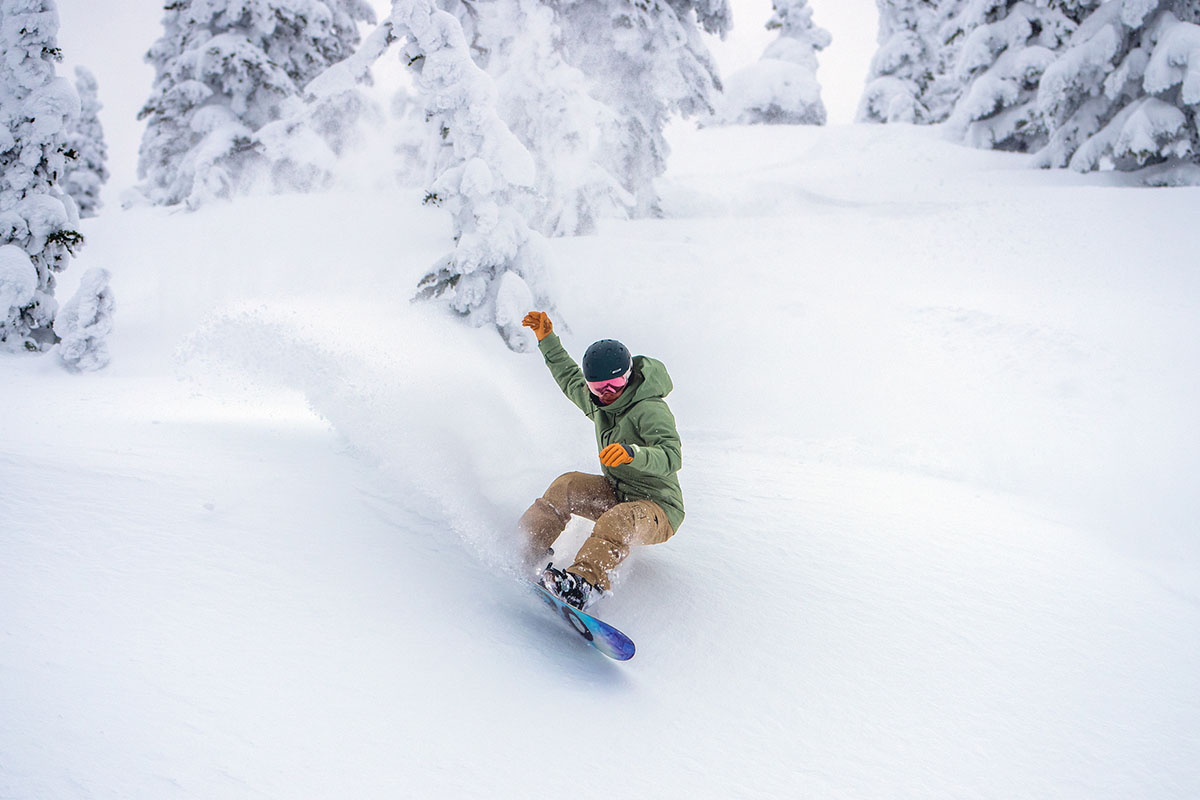
Due to the stop-and-start nature of snowboarding—riding lifts, strapping in and out, and resting in the park—many resort riders prefer jackets with built-in insulation. The amount of warmth varies widely, so it’s essential to consider how much you actually need. If you tend to get cold easily or ride in consistently frigid conditions, a well-insulated jacket is ideal. However, if you overheat quickly or ride in variable temperatures (like in the Pacific Northwest), opting for light insulation—or no insulation at all—may be the smarter choice. Overheating in a jacket that’s too warm can lead to issues like fogged-up snow goggles or excessive sweating, which can make you colder in the long run.
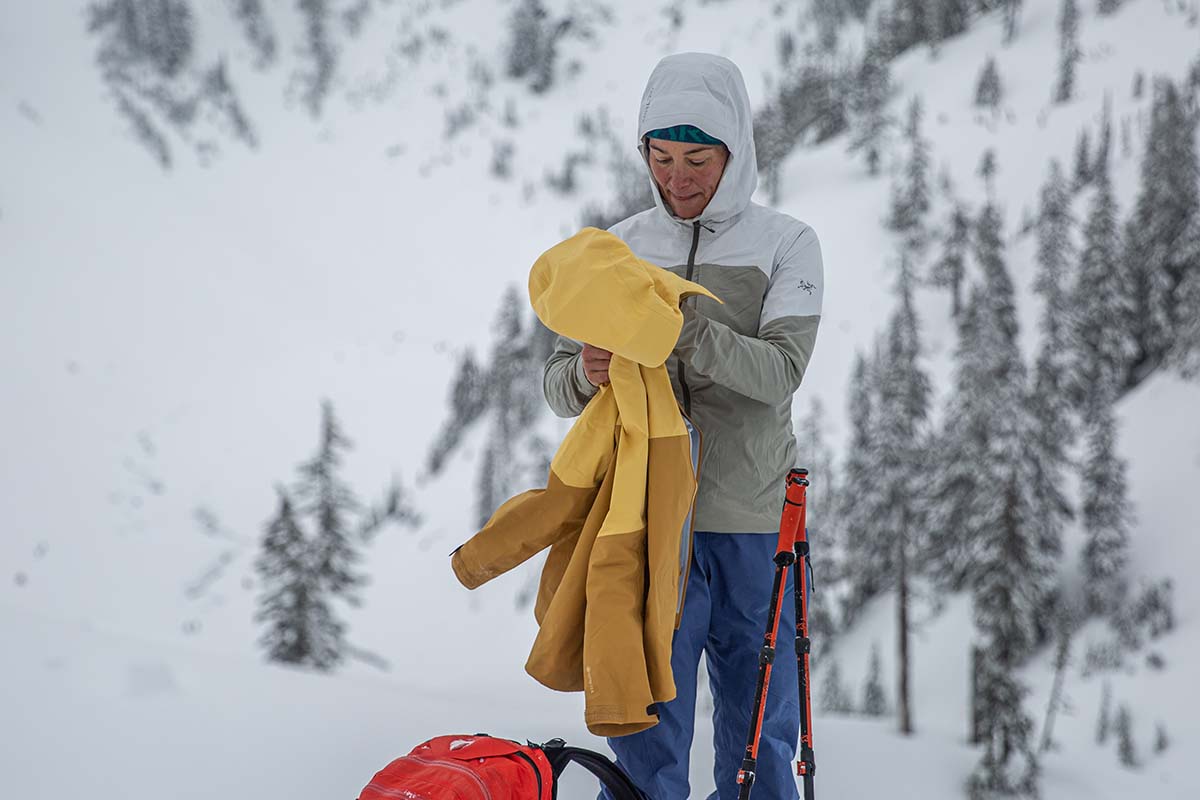
Most snowboard jackets use synthetic insulation, measured in grams per square meter (gsm). While quality plays a role in warmth, you can make generalizations based on the insulation weight. Jackets with 40- to 60-gram synthetic fill are on the lighter end, requiring an additional midlayer in typical winter conditions. This amount of insulation is great for moderate days or when mixing in sidecountry hikes. For those looking to ditch their midlayer in all but the coldest conditions, stepping up to an 80-100-gram insulated jacket is the better choice. Additionally, many jackets concentrate insulation around the core and use less insulation in the sleeves or hood; this helps retain warmth while reducing bulk and maintaining mobility.
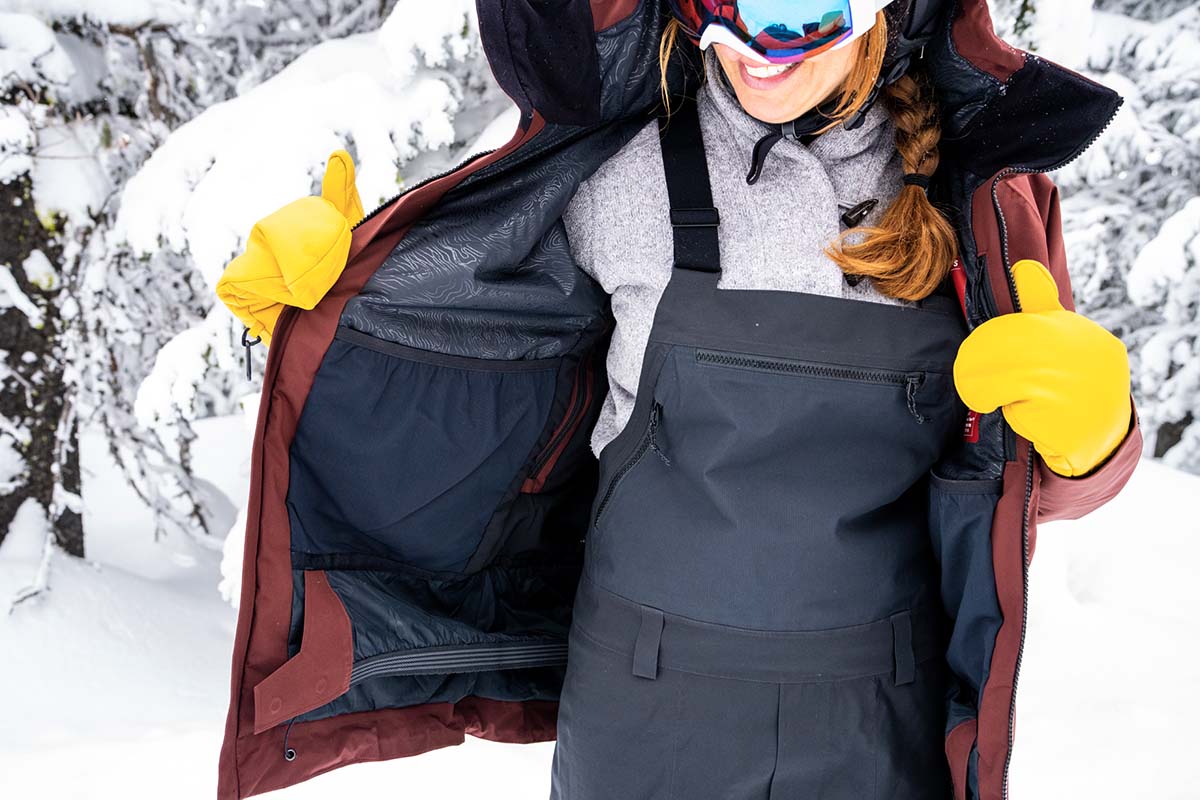
Construction
All jackets listed in this guide provide snow and wind protection, though performance varies based on three key factors: the waterproof membrane, the DWR coating, and the quality of seam taping. Gore-Tex remains the gold standard for waterproofing, available in both a mid-range 2-layer design and a lighter, more breathable 3-layer version. These jackets consistently provide top-tier protection in harsh and wet conditions. However, many brands offer in-house waterproofing alternatives to lower costs—Helly Hansen’s Helly Tech Professional and Trew Gear’s Primo are notable examples. Budget-friendly snowboard jackets ($250–$350) still offer adequate waterproofing for moderate and dry conditions, but they often lack the durability and reliability of premium options in sustained wet weather.

Durable Water Repellent (DWR)
DWR coatings are applied to the jacket’s outer fabric to prevent moisture from soaking into the material. This keeps the internal waterproof membrane from being overwhelmed by water, which could otherwise compromise breathability and even lead to leaks. A well-functioning DWR ensures that water beads up and rolls off rather than soaking in. Many budget snowboard jackets under $250 lack a DWR coating, which is why we recommend spending a bit more for better performance—especially for riders in wetter climates like the Pacific Northwest.

Seam Taping
Seam taping is crucial for keeping moisture from seeping through fabric connection points. Higher-end jackets feature fully taped seams, while budget models—like the 686 Athena Insulated—often limit seam sealing to “critical” areas like the shoulders and front zipper. Another consideration is the quality of the seam taping itself: Arc’teryx leads the market with thin, lightweight, and highly durable taping, whereas lower-end taping can degrade or peel over time.
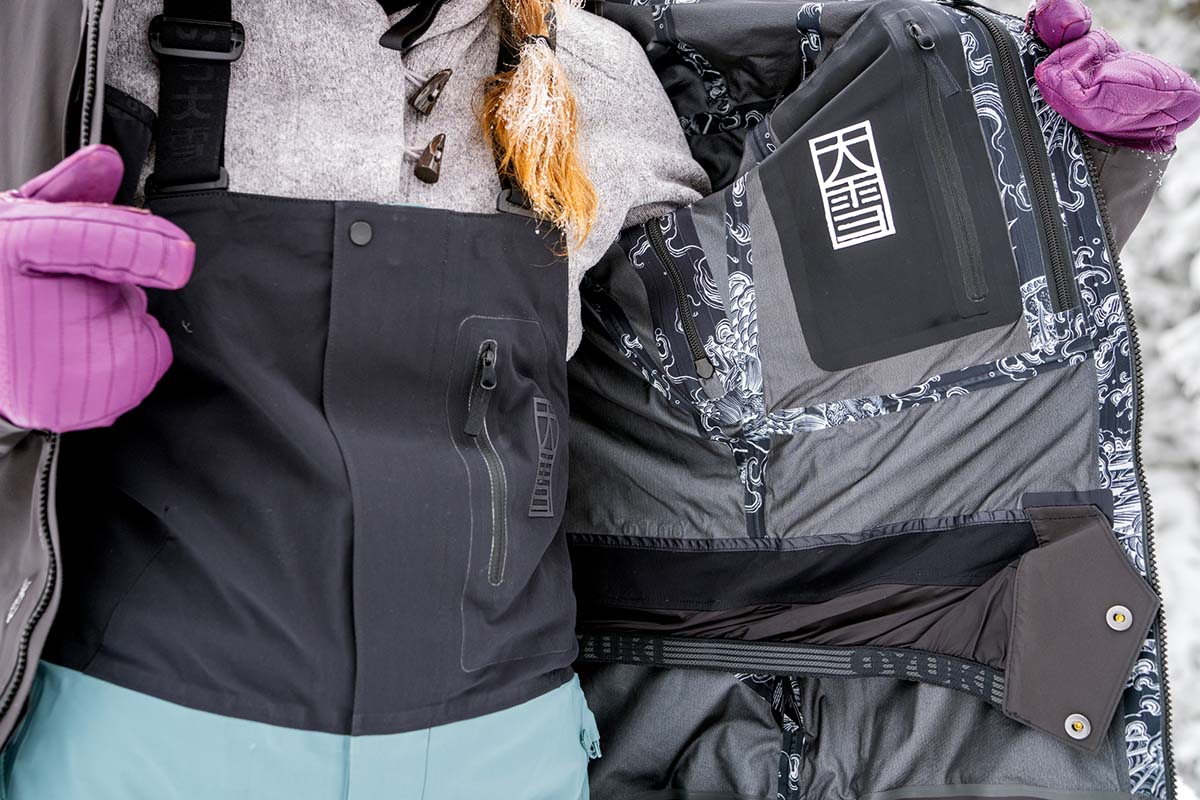
For most resort riders, breathability isn’t a top priority. As long as insulation is kept in check, most jackets provide enough airflow for typical groomer runs and short sessions in the trees. However, for those who enjoy hiking, sidecountry riding, or splitboarding, breathability becomes much more important. Among waterproof snowboard jackets, the best breathability comes from uninsulated shells with 3-layer constructions, where the outer fabric, waterproof membrane, and liner are bonded together. Jackets like the Arc’teryx Sentinel excel in moisture management, effectively pulling sweat away and releasing heat. If breathability is your top concern—such as for springtime splitboarding—you may want to consider a non-waterproof softshelll. These jackets are more air-permeable and provide better ventilation but sacrifice weather protection, making them less ideal for resort use.
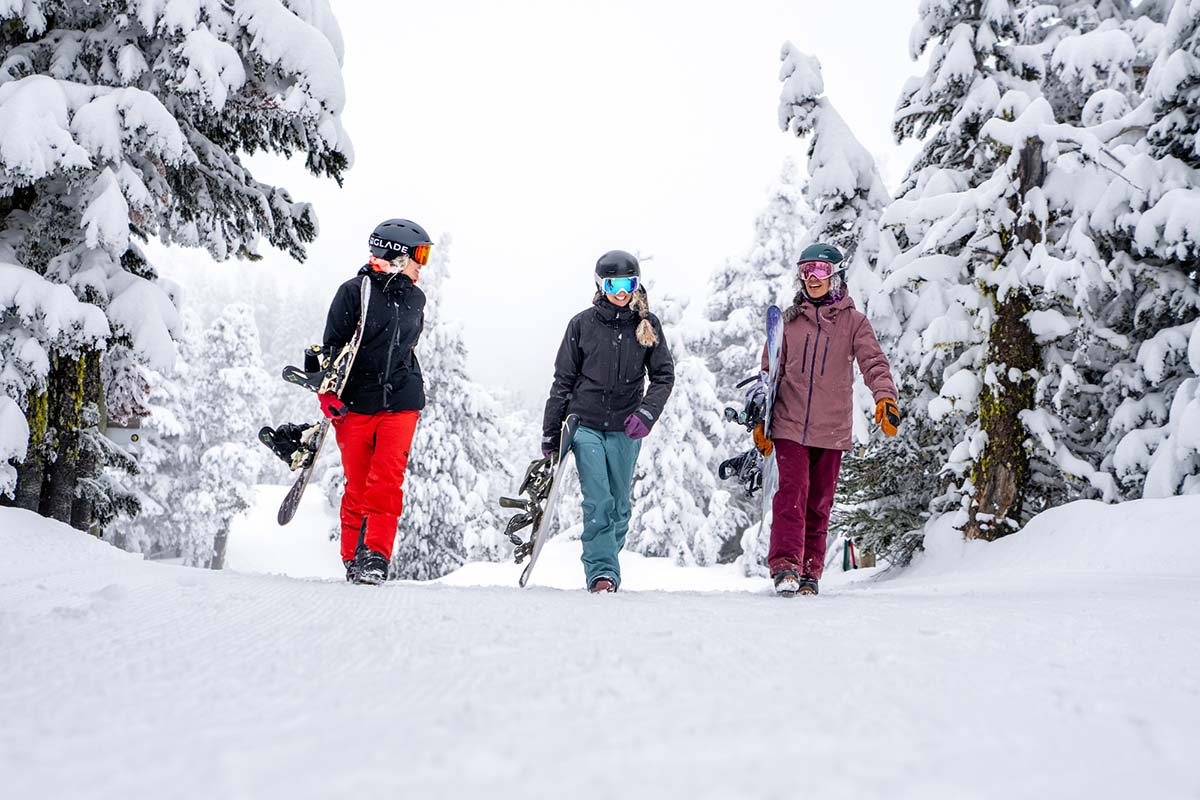
When researching snowboard jackets, you’ll frequently see two key specifications: a waterproof rating (measured in millimeters) and a breathability rating (measured in grams). Waterproofing is typically tested using a static-column method: A piece of the jacket’s shell fabric is placed under a 1-inch diameter tube, which is then filled with water until the fabric starts to leak. The height of the water at failure determines the jacket’s waterproof rating. Meanwhile, breathability ratings measure how much water vapor can pass through the fabric over a 24-hour period.

It’s important to recognize that these lab tests don’t perfectly replicate real-world conditions, so we don’t recommend focusing too heavily on the numbers. In particular, breathability ratings vary widely in testing methods, making direct comparisons between brands unreliable. There is some value in the static-column rating—a higher number will typically lead to better waterproofing—but plenty of other factors come into play, including DWR coating, fabric denier, and seam taping. Instead, consider overall jacket construction: spending more generally results in better waterproofing (Gore-Tex is a solid choice), and for better breathability, opt for a high-end, uninsulated shell.
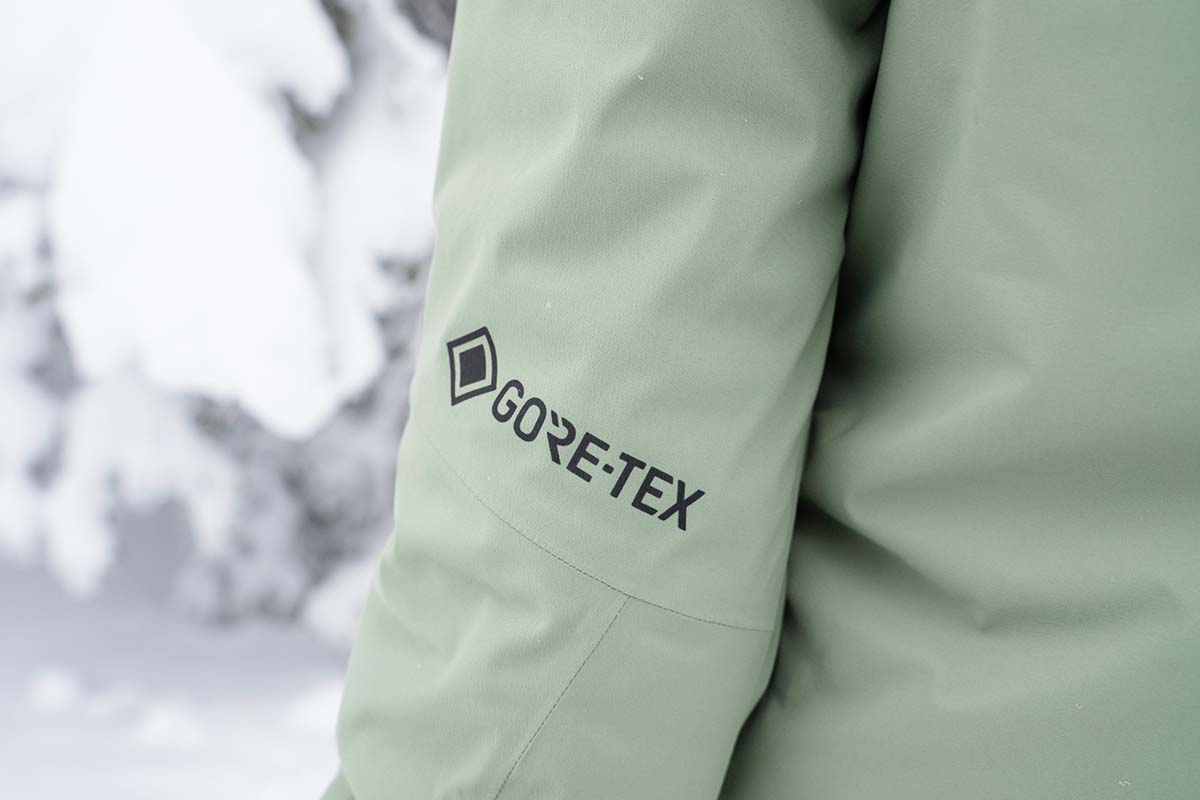
Snowboard jackets are built tough, using durable face fabrics to handle harsh weather and endure the wear and tear of chairlifts, park features, and sharp gear. Unlike rain or hardshell jackets, most snowboard jackets don’t list fabric denier (a measure of thread thickness and density), making direct comparisons tricky. However, designs generally fall into broad categories: budget jackets tend to be thick and tough to enhance weather resistance, while mid-range options use higher-end, lighter materials that maintain durability. Backcountry and technical shells typically sacrifice a bit of toughness in favor of reduced weight and increased mobility, but even lighter designs like the Outdoor Research Hemispheres II and Arc’teryx Sentinel have proven to be impressively rugged.
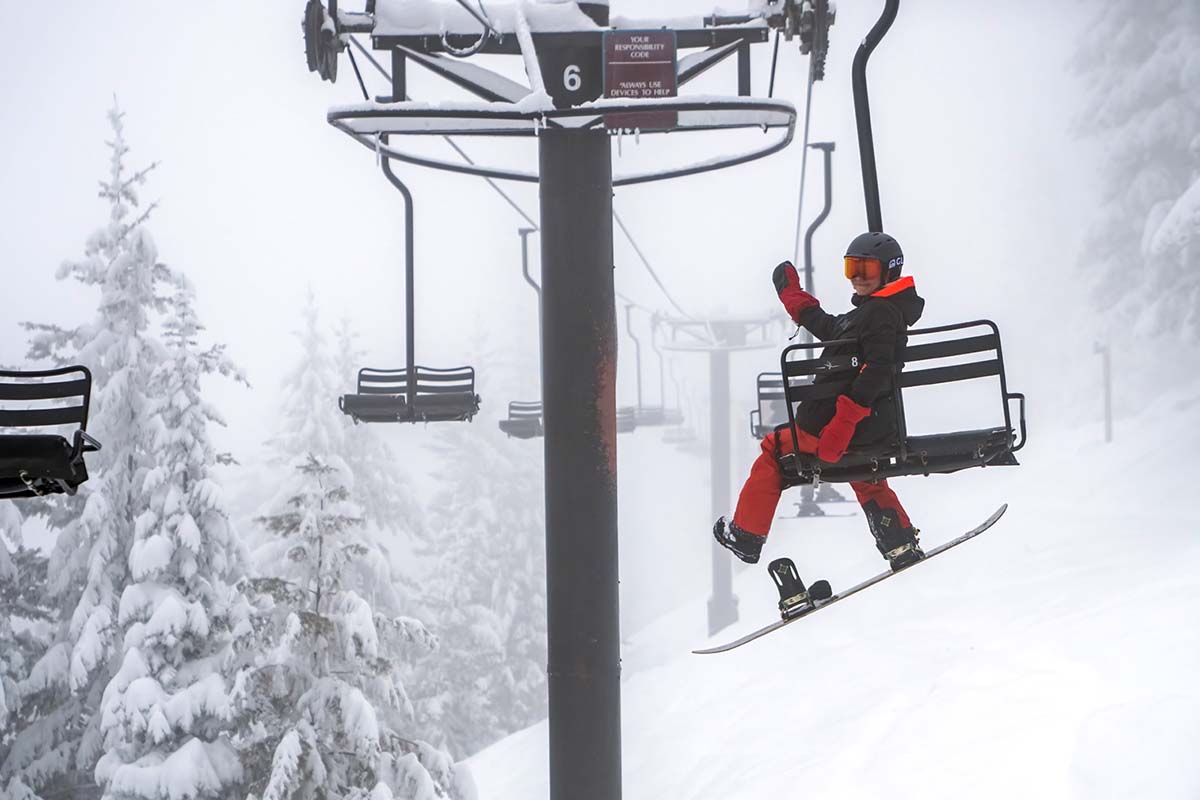
Weight and durability go hand in hand—a heavier, more durable snowboard jacket typically has thicker fabrics and a beefier construction. Weight also varies by category: shells are the lightest, insulated models strike a middle ground, and 3-in-1 jackets tend to be the heaviest. For most resort riders, weight isn’t a major concern, as a slightly heavier design doesn’t significantly impact comfort or performance. However, if you spend a lot of time off-trail or in the backcountry, a lightweight shell can improve mobility and overall comfort. A standout in this regard is the Arc’teryx's Sentinel, which delivers top-tier protection while feeling barely noticeable throughout the day.

Snowboard jackets are generally cut larger and baggier than ski jackets, a design choice that enhances both style and functionality. Most riders—whether at the resort or in the backcountry—prefer sizing up for added mobility and a relaxed feel. The extra room accommodates midlayers like fleece, synthetic, or down jackets, preventing binding or restriction. Back length is another key factor: Most snowboard jackets offer plenty of coverage for sitting on the lift or in the snow, but park-specific designs may be excessively long for active riding, while some backcountry-focused models may be a bit short for resort use.

Hood
A helmet-compatible hood (meaning it’s large enough to fit over your helmet) is essential for protection against high winds and heavy snowfall. Higher-end designs offer better adjustability—allowing for a secure and even fit over a snowboard helmet—while cheap models will offer less adjustability. Premium models also feature a stiffened brim to help deflect snow from goggles. Some of the best hoods include those on Burton’s [ak] jackets, Arc’teryx’s StormHood, and mid-range options like the Patagonia Storm Shift and Trew Gear Stella Primo.
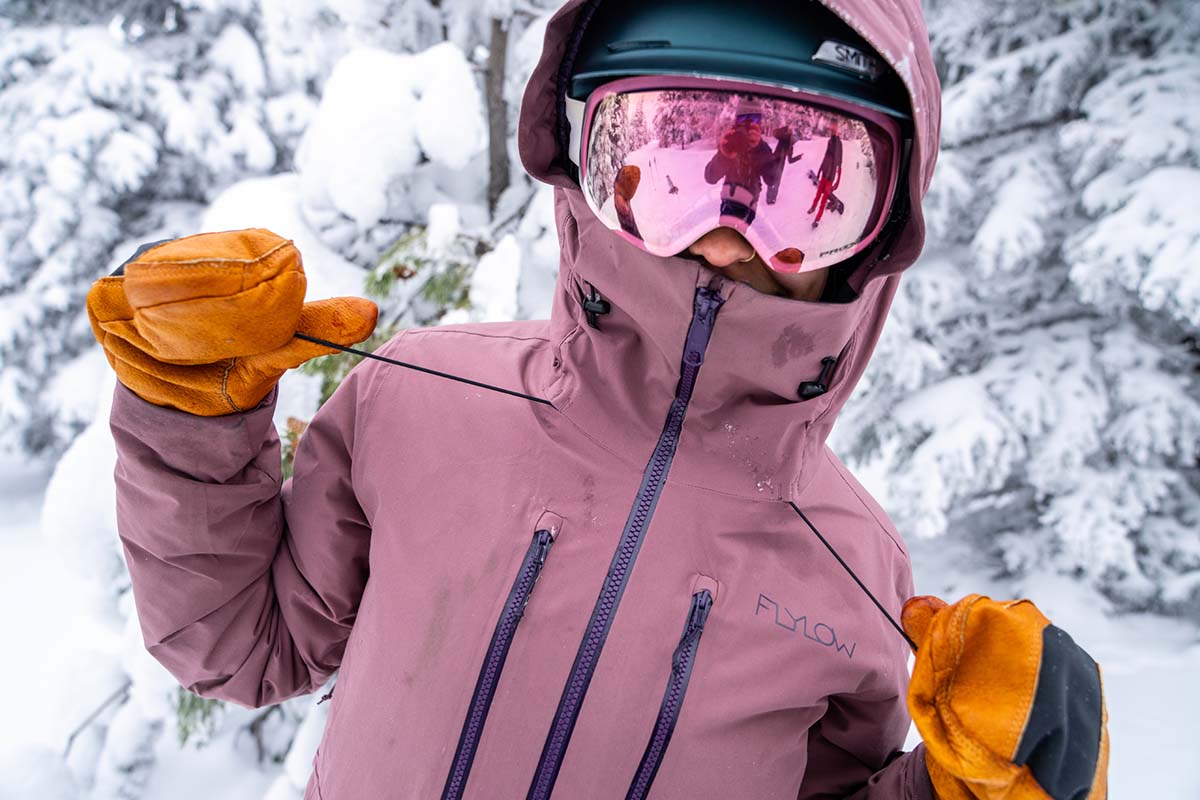
Cuffs and Wrist Gaskets
Nearly all snowboard jackets include Velcro-adjustable cuffs, allowing you to customize the fit to keep snow out and warmth in. Most riders prefer wearing their jacket cuffs over their gloves or mittens, and the Velcro closure ensures a secure seal around the wrist. If you’re dealing with deep snow or heavy powder days, a well-fitted cuff can make all the difference in preventing snow from sneaking in. Some jackets also incorporate stretchy inner cuffs, providing an additional layer of protection against the cold.

Many resort-oriented snowboard jackets also feature wrist gaskets—elastic, form-fitting extensions designed to create a tight seal around the wrist. These can be highly effective in keeping snow from creeping up the sleeves, but not all wrist gaskets perform equally well. Some thicker, neoprene-style gaskets tend to absorb moisture, which can lead to discomfort as they become heavy and cold over time. On the other hand, thinner, mesh-like wrist gaskets—such as those found on the Burton [ak] Embark—offer better breathability and moisture resistance while still providing excellent snow protection. If you frequently ride in wet or variable conditions, opting for a jacket with quick-drying and lightweight wrist gaskets can improve overall comfort.

Pockets and Organization
Most snowboard jackets include an assortment of pockets, with premium models offering more specialized storage. A dedicated chest pocket is ideal for keeping essentials like a phone or wallet easily accessible, and some designs—like Burton’s Therma-Pocket—feature insulation to prevent phone batteries from draining in cold temperatures. Handwarmer pockets are another staple, providing a convenient spot to warm up gloved hands. If you use an RFID pass, look for an exterior sleeve pocket for quick scanning. Riders who need to carry larger items—such as goggles, gloves, or splitboard skins—will appreciate spacious mesh drop-in pockets found on jackets like the Outdoor Research's Hemispheres II.

Pit Zips (Underarm Vents)
Pit zips are an underrated but highly valuable feature. On warm days, during sidecountry hikes, or after layering too heavily, unzipping these vents can quickly dump excess heat. The biggest difference between designs is whether the vents are mesh-lined. Mesh lining prevents snow from entering but slightly reduces airflow, while unlined vents maximize ventilation but can let in moisture. Regardless of preference, we highly recommend choosing a jacket with pit zips (fortunately, most of our top picks include them).
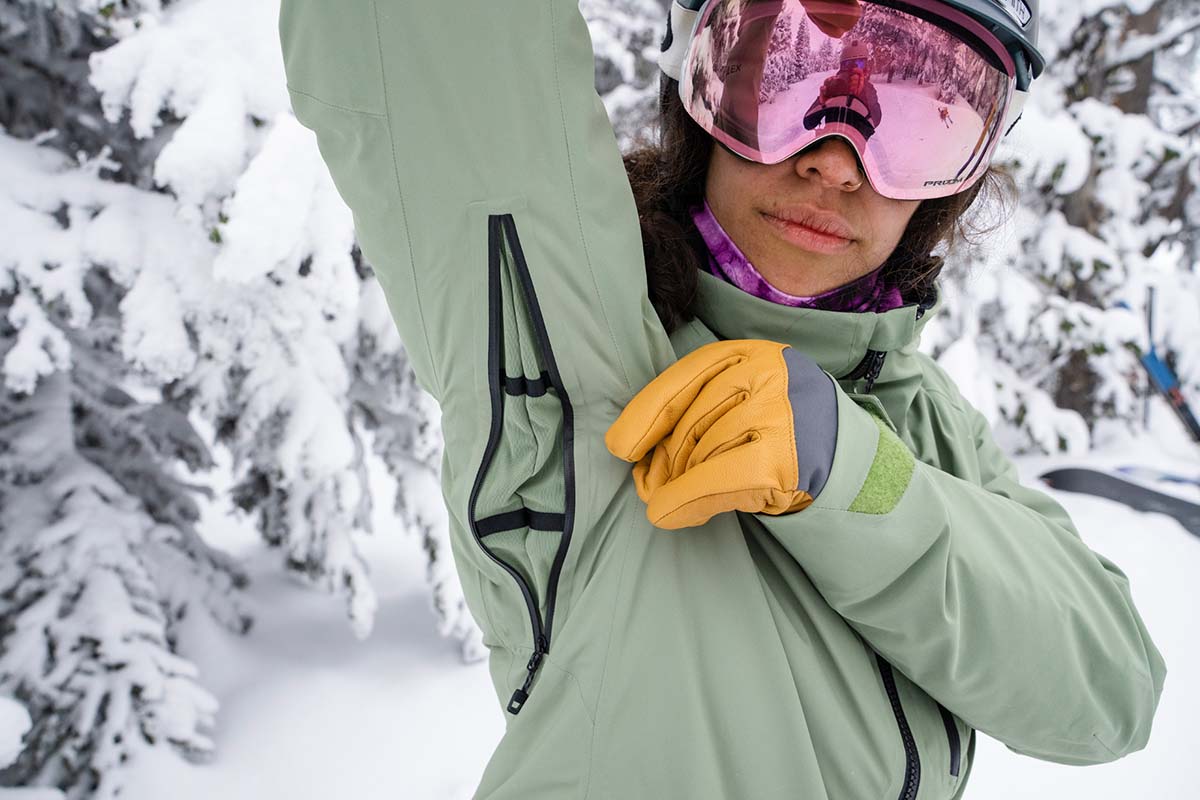
Powder Skirt
A powder skirt (or waist gaiter) is a built-in elastic barrier positioned inside the jacket above the hem. It provides extra protection against snow when riding in deep conditions or after a fall. While useful, powder skirts aren’t always necessary—an extended back length and a cinched hem often provide enough coverage for most resort days. Some riders find powder skirts annoying when left unbuttoned, as they can hang loosely and add bulk. For added versatility, some jackets feature zip-out powder skirts, which can be removed on warm days.

Jacket-to-Pant Attachment System
For those seeking maximum protection, some brands offer jacket-to-pant integration systems. These vary in design—from simple button loops (as seen in Patagonia jackets) to fully zippered interfaces (like Volcom’s Zip Tech). These systems create a nearly seamless barrier against snow and wind, making them a great option for riders prone to frequent falls or those who enjoy deep powder. However, they require snowboard pants from the same brand to work properly.

Recco Reflectors
Many mid- to high-end snowboard jackets feature built-in Recco reflectors, which help resort search and rescue teams locate riders in avalanche-prone areas. Unlike dedicated avalanche beacons, Recco reflectors don’t require batteries and function passively, reflecting signals from Recco detectors. While they’re no substitute for a proper beacon in the backcountry, they do provide an added layer of safety for those venturing off-trail. More information can be found on the Recco System website.

Sustainability has become a major focus in snowboard apparel, with brands increasingly using recycled materials and PFC-free DWR coatings (traditional coatings contain perfluorinated chemicals, or PFCs, which are environmentally harmful). Some states are beginning to ban the sale of PFC-treated items, prompting the outdoor industry to develop eco-friendlier water- and stain-resistant alternatives( for more, you can read about Patagonia’s take on the issue). Many jackets now use bluesign-approved fabrics, meaning the materials were sourced and produced with minimal environmental impact. Additionally, Fair Trade certification is becoming more common, ensuring fair labor practices in production.
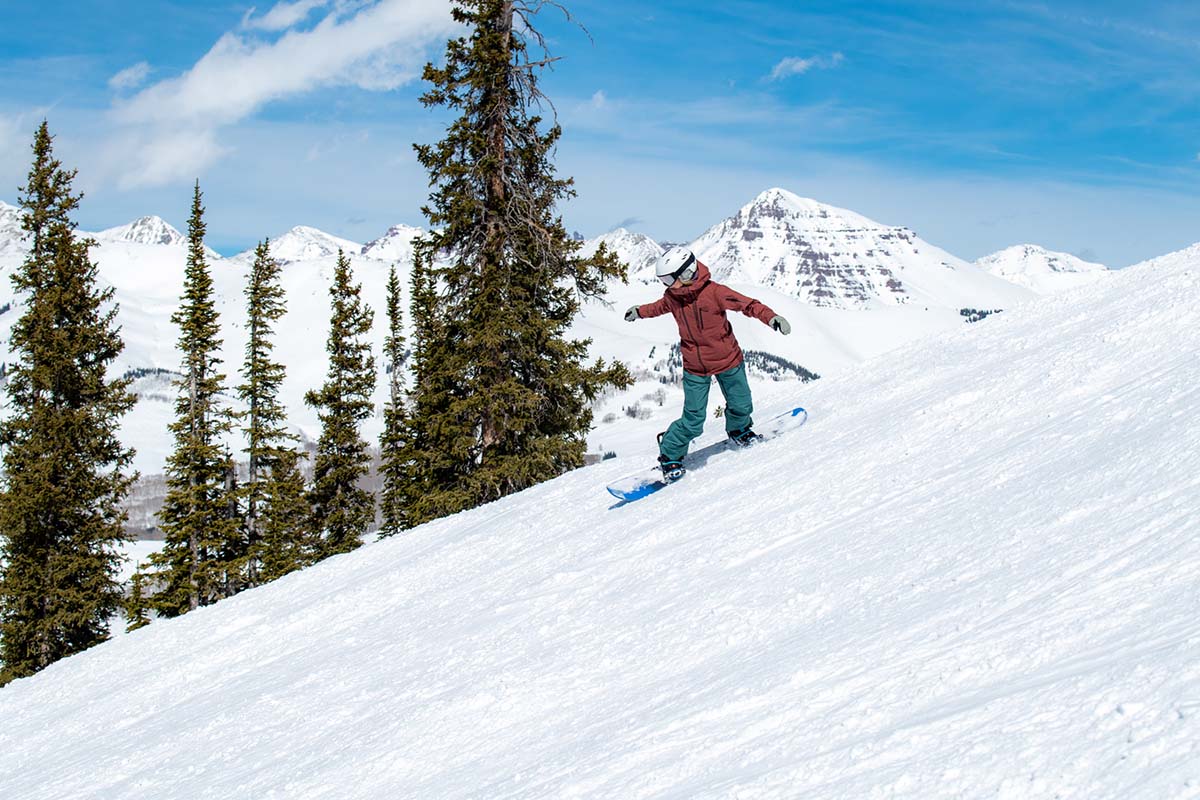
Patagonia leads the industry in sustainable snowboard gear, with its Storm Shift jacket boasting Fair Trade Certification, a 100% recycled and PFC-free Gore-Tex membrane, and a partially recycled lining with PFC-free DWR. Other brands making notable progress include Burton, Picture Organic, and Jones. While the industry still has room to improve, the momentum is encouraging. A final way to shop sustainably is by investing in high-quality gear built to last and repairing worn-out items instead of replacing them prematurely.
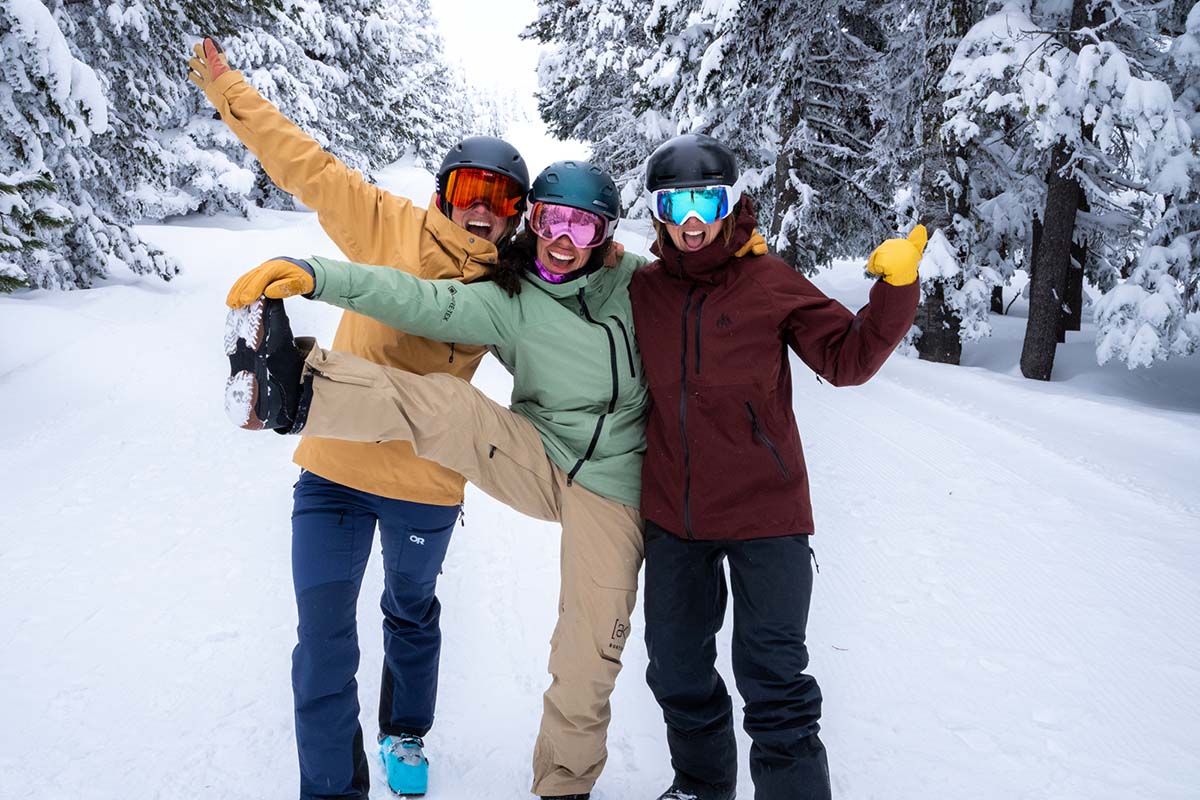
Because of the similarities between the two sports, many snowboard jackets can double as ski jackets and vice versa. In fact, some brands—including Patagonia and Arc’teryx—explicitly market their jackets as suitable for both activities. However, there are a few key differences. Snowboard jackets typically have a looser fit for increased mobility and a longer back length for extra protection when sitting on the snow. Additionally, snowboarders tend to favor mittens over gloves (as they don’t need to grip poles), so many snowboard jackets feature larger, easier-to-use zipper pulls. While these differences are worth considering, they aren’t deal-breakers for most riders. For those curious about crossover options, check out our guide to the best women’s ski jackets.
Back to Women's Snowboard Jacket Picks Back to Women's Snowboard Jacket Comparison Table